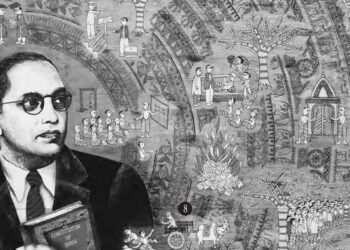But the most outstanding event of the year concerning the struggle of the Depressed Classes was the satyagraha or the passive resistance sponsored by Ramaswami Naicker, a non Brahmin leader, at Vaikam in the Travancore State for vindicating the rights of the Untouchables to the certain roads to which they were forbidden entry. Its moral pressure and the spirit of righteous assertion had a tremendous effect, and the orthodox Hindus, for a while, regained their civic sense and sanity, and the road was thrown open to the Untouchables.
Another incident took place at this time. It shook both sensible touchables and self-respecting Untouchables. In March 1926 an Untouchable by name Murgesan entered a Hindu temple in Madras despite the customary ban on the Untouchables. He was discovered, arrested and convicted on a charge of defiling the Hindu temple.
Ambedkar was watching these developments very carefully. He referred to the Vaikam struggle, a few months later, very touchingly in one of this editorials, on the eve of the Mahad satyagraha. These were notable events. Coming events cast their shadows before!
(The following observation of Babasaheb
Dr. B.R. Ambedkar was made immediately after the verdict of the Supreme Court of India, upholding the verdict of Madras High Court that invalidated Communal G.O. for the reservation in admission in higher education and employment in public services in Madras State. At that time Babasaheb was the Union Law Minister)
On invalidation of Communal G.O.
Meanwhile, some decisions of the High Courts and an important decision of the Supreme Court raised some vital points in connection with Article 15(1) and Article 29(2). The Supreme Court invalidated the Madras State Government’s Communal Order on admission of students to colleges and services. A series of court decisions nullified the Article 19(2) and Article 18 in respect of freedom of speech and property. So the Union Government moved the Constitution Amendment Bill in Parliament stating that the Bill sought no other changes, but brought out what was implicit in the Constitution and gave effect to the intentions of that charter. Ambedkar rose in an expectant House to defend the Amendment. “Then slowly and deliberately,” observed the special correspondent of The Times of India, Bombay, “but with all the weighty almost inevitable decision of the steam roller in motion, Dr.Ambedkar expanded its real purpose and meaning, and crushed much of the criticism, which when he rose to speak, seemed to have decimated Prime Minister Nehru’s original statement when he initiated the discussion.”
Turning to the Supreme Court judgment, which had invalidated the Communal Order of the Madras State Government on the ground that it involved discrimination between castes, Ambedkar remarked that “it was utterly unsatisfactory and was not in consonance with the Articles of the Constitution”. This remark created a storm in the House. When it died down, Ambedkar explained that the Supreme Court had overlooked the operative word “only” in Article 29(2) – “No citizen shall be denied admission into any educational institution on grounds only of religion, race and caste.” He further stated that Article 46 directed the State to protect the interests of weaker classes. If then Article 46 was to be fulfilled, he added, the Articles 16(4) and 29(2) must be amended. The Amendment to Article 19(2) involved the addition of three more heads of restrictions to the freedom of speech and expression, public order and incitement to an offence and friendly relations with foreign states. This part of the Amendment also he supported.
The result was that the motion was approved and the Bill was referred to a Select Committee. The overwhelming decision in favour of the motion was largely the result of a very eloquent and impressive speech delivered by Dr.Ambedkar. “His peroration for its incisiveness and lucidity of exposition concerning difficult and delicate constitutional and legal issues must rank as one of the most outstanding debating performances ever witnessed in this Parliament,” concluded the correspondent of The Times of India.








